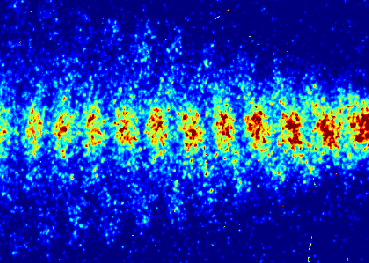From their previous experiments, the scientists knew that the modulation was brought about by the intrinsic properties of the set-up. “We are helped by an interaction between particles and plasma that we call ‘self-modulation’”, says Patric Muggli, AWAKE project leader at the Max-Planck-Institute for Physics and Chairman of the Physics and Experiments Board at AWAKE. “During this process, the long beam breaks down into energy-rich proton bunches only a few millimeters in length which build up to form a large wakefield.”
Spot on proton bundles
For the first time, the scientists were able to directly observe the “train” made up of short proton bundles that transports and accelerates other particles by using an ultra-fast camera with a resolution of one pico-second (one millionth of one millionth of a second).
They were able to show that protons actually leave the beam to form the drive beam and that this effect becomes stronger along the bunch and the plasma. Moreover, they demonstrated that the distance between the bundles is determined by the plasma density and can thus be changed. All of these observations confirm the theory and simulation results that were used to conceive the experiment.
Settled for future experiments
Furthermore, a detailed understanding and measurement of these processes are crucial to designing a future instrument, which will accelerate electrons to high energies in a good quality. This new experiment will use an inital plasma, “the self-modulator”, in which the proton bunch train will be formed, as in the reported experiments.
This will be followed by a gap without plasma into which the electron beam to be accelerated will be injected. Both beams will then travel along the second plasma, “the accelerator”, where the plasma will remove energy from the proton beam and transfer it to the electron beam.
Aiming at the innermost structure of the proton
The proton beam carries a lot of energy that can be transferred to the electrons. “The high initial energy is in actual fact the advantage of using a proton beam rather than a laser or electron beam, as in previous experiments”, says Muggli.
“In the future, the new acceleration technique could be used to produce high-energy electrons and collide them with high-energy protons to explore the inner structure of the proton.” Unlike the electron, this particle is not elementary: it consists of smaller components (quarks and gluons) and has a complex internal structure.
However, there is still a lot of work and science to be done before scientists can actually benefit from the new accelerator technology. Initial applications for particle physics can be expected in a decade or so.
Publications:
- Experimental Observation of Plasma Wakefield Growth Driven by the Seeded Self-Modulation of a Proton Bunch; M. Turner et al. (AWAKE Collaboration); Phys. Rev. Lett. 122, 054801 (2019)
- Experimental Observation of Proton Bunch Modulation in a Plasma at Varying Plasma Densities; AWAKE Collaboration; Phys. Rev. Lett. 122, 054802 (2019)
Contact:
Dr. Patric Muggli
Max Planck Institute for Physics
+49 89 32354-580
+41 75 411-4823 (CERN)
